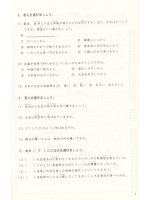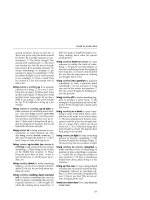Graph practice phần 2 ppsx
Bạn đang xem bản rút gọn của tài liệu. Xem và tải ngay bản đầy đủ của tài liệu tại đây (54.19 KB, 12 trang )
The best answer is C.
There is no other way, check the approximate ratio in each of the categories.
A. 13 hours to 4500 dollars, which is approximately 1:350.
B. 6.5 hours to 2400 dollars, which is approximately 1:370.
C. 7.5 hours to 1250 dollars, which is approximately 1:170.
D. 8 hours to 1400 dollars, which is approximately 1:175.
E. 3 hours to 750 dollars, which is approximately 1:250.
And therefore the closest ratio is C.
9. If there are 87 working hours per day in the factory of car X, approximately how
many cars can be manufactured in 3 days?
A. 2.
B. 4.
C. 6.
D. 8.
E. There isn’t enough data to determine.
The best answer is C.
If you sum up the entire time of building a car, you’ll get approximately 43.5 hours.
If there are 87 working hours in one day then two cars can be made, thus 6 cars can be
manufactured in 3 days.
Kitchen appliances sold at Arnolds electric store during
December
0 5 10 15 20 25 30 35
Mixers
refrigerators
ovens
Microwaves
Number of appliances sold
Made in China Made in U.S
Living room appliances sold at Arnolds electric
store during December
01020304050
Televisions
Speakers
D.V.D's
V.C.R's
Number of appliances sold
Made in China Made in U.S
1. Approximately what percent of all appliances sold in the Arnolds electric store
were Ovens and televisions?
A. 10%.
B. 20%.
C. 30%.
D. 40%.
E. 50%.
The best answer is C.
In this question you’ll need to use the data from both graphs.
Sum up the bars of both the ovens and the televisions. They both sum up to 58.
Sum up the bars of all the appliances in all the categories, they will sum up to
approximately 200 or so. Now, 58 out of 200 are a little under 30% and therefore
answer C is the best answer.
2. If X represents the number of DVD’s that were made in U.S and were sold during
December, how many Televisions that were made in the China sold that month?
A. X.
B. 1.5X.
C. 2X.
D. X/2.
E. 6X.
The best answer is E.
According to the bar chart, X represents approximately 5 DVD’s that were sold.
Go to the T.V category, you can see that approximately 30 televisions that were made
in china were sold in December and therefore the answer is 30/5 = 6X.
3. For the individual category in which the second greatest number of appliances
made in the U.S were sold, the number of appliances made in the U.S exceeded the
number of appliances made in China by how much approximately?
A. 0.
B. 1.
C. 2.
D. 3.
E. 4.
The best answer is C.
First identify the category in which the number of appliances made the U.S is the
second in size, which would have to be the “ovens” category. In that category 14
(U.S) ovens were sold and (China) 12 ovens were sold. The difference is 2 ovens and
therefore the answer is C.
4. According to the graph, to which of the following categories was the ratio between
appliances that were made in China to appliances that were made in the U.S the
greatest?
A. Refrigerators.
B. Mixers.
C. Speakers.
D. Televisions.
E. DVD’s.
The best answer is
Check the approximate ratio in each of the options:
A. 6 to 6, which is 1.
B. 11 to 3, which is 3 and two thirds.
C. 15 to 28, not relevant since B is greater.
D. 30 to 2, which is 15- we got a winner.
E. 13 to 5, not relevant since D is better.
And therefore the greatest ratio will be in the Televisions categories.
$0
$5,000
$10,000
$15,000
$20,000
$25,000
19911992199319941995
Total Revenues (in dollars)
Non-organic materials
Organic materials
$0
$1,000
$2,000
$3,000
$4,000
$5,000
$6,000
$7,000
$8,000
$9,000
$10,000
19911992199319941995
Total profits (in dollars)
Non-organic materials
Organic Materials
Percent of revenues from Non-organic materials in
1994 according to catagories
60%
28%
12%
Clay
Glass
Metal
Geeweez Inc.
Revenue and profit distribution for Organic and Non-organic materials
Over the years 1991 to 1995.
The 3 first graphs should be attached here.
1. Approximately how much did the total revenues increase from 1991 to 1995?
A. $4,400.
B. $5,000.
C. $6,500.
D. $8,000.
E. $11,200.
The best answer is C.
First familiarize your self with the graphs.
The question is about the graph of the revenues, look at the difference between the top
value of the column in 1991 and 1995. You can see that the difference between the
years is approximately (21,500 – 15,000 = 6,500) and thus the answer is C.
2. In the year which profits from Organic materials decreased over the previous year,
the revenues from Non-organic materials were approximately
A. $12,500.
B. $10,000.
C. $7,500.
D. $6,200.
E. $4,000.
The best answer is A.
Refer to both bar graphs. Look for the year in which the Organic bar is lower than its
previous year, the only year is 1995. Then go to the other bar graph and look again in
the year 1995, the revenues from Non-organic materials are (15,000 – 2,500 = 12,500)
and thus the answer is A.
3. In the year which profits from Organic materials are the lowest, what percent
approximately of the total revenues belong to the Organic materials?
A. 22%.
B. 28%.
C. 35%.
D. 45%.
E. 65%.
The best answer is C.
Refer to both bar graphs. From the profit graph, we can learn that the question is
asking about the revenues of the year 1993. In that year, revenues from Organic
materials present approximately $8,000 and the total revenues are approximately
$22,000. In percent terms the answer is (8/22 = approximately 36 percent) and so the
best answer is C.
4. In 1994, total profits represented approximately what percent of Geeweez’s total
revenues?
A. 25%.
B. 30%.
C. 40%.
D. 50%.
E. 65%.
The best answer is C.
Refer to both bar graphs. From the profit graph, we can conclude that the total profits
for 1994 are approximately $9,500. From the revenue graph, we can conclude that the
total revenues are approx. $24,000.
(9,500 / 24,000) in percent terms is approx. 40% and thus C is the answer.
5. The profits on Non-organic materials in 1992 are approximately what percent of the
total revenues in 1994?
A. 15%.
B. 25%.
C. 35%.
D. 45%.
E. 55%.
The best answer is B.
Refer to both bar graphs. Look in the year 1992 in the profit graph, the profits from
the upper bar column, which belongs to the Non-organic materials is approx. (10,000
– 4,000 = 6,000). In the year 1994, the total revenues are approx. $24,000 and thus the
answer in percent terms is (6/24 = 0.25) 25%.
6. For the first year in which Non-organic materials revenues surpassed $16,000, total
profits were approximately
A. $3,200.
B. $6,500.
C. $8,000.
D. $9,500.
E. $10,500.
The best answer is A.
Look at the revenues graph, start in 1991 and go through the years until you find one
that the revenues from Non-organic materials is over $16,000, the first possible year
is 1994. Now go to the second graph and see how much profits were made that year,
the answer is approx. $3,200.
7. For the last year in which profits from Organic materials were under $2,000,
approximately what were the total revenues in the previous year?
A. $15,000.
B. $17,500.
C. $22,000.
D. $24,000.
E. $21,000.
The best answer is D.
This is a tricky question, pay attention.
We were asked about the last year so start from 1995 and move down the years. In
1995 the profits from Organic materials were under $2,000 and so the question is
asking the total revenues in the previous year, thus in 1994.
The answer is approx. $24,000.
8. In 1994, what were the Non-organic revenues, which belong to the Metal group?
A. $8,500.
B. $9,600.
C. $10,800.
D. $12,000.
E. $13,200.
The best answer is C.
First look at the revenue bar graph, the total Non-organic revenues are $18,000.
Now move to the pie graph, you can see that the metal group is 60% of the total and
therefore 60% of 18,000 are the correct answer. (0.6 x 18,000 = 10,800).
9. Of the Non-organic revenues in 1994, how much approximately were not made
from metal or glass?
A. $2,150.
B. $3,200.
C. $4,100.
D. $5,000.
E. $5,500.
The best answer is A.
First look at the revenue bar graph, the total Non-organic revenues are $18,000.
Now move to the pie graph, you can see that the metal group is 60% of the total and
the glass group is 28% and therefore 12% of 18,000 are left, which are also the clay
group. (0.12 x 18,000 = 2,160). The closest answer is A.
10. What percent approximately are the revenues of the Non-organic Metal materials
in 1994 relative to the total profits in the years 1994 and 1995?
A. 25%.
B. 35%.
C. 45%.
D. 55%.
E. 65%.
The best answer is D.
First look at the revenue bar graph, the total Non-organic revenues are $18,000.
Now move to the pie graph, you can see that the metal group is 60% of the total and
therefore 60% of 18,000 are $10,800.
Now go to the profits graph, the total profits in 1994 and 1995 are approx. $19,000.
In percent terms, 10.8/19 is approximately 55% and thus answer D is the best.
Game Balance of 5 different teams in 1999
0
10
20
30
40
50
60
70
Team ATeam B Team CTeam DTeam E
Games
Win
Lose
Tie
1. The team that made the finals played 50% more games. Which of the following
teams made it to the finals?
A. Team A.
B. Team B.
C. Team D.
D. Team E.
E. Answers B and C.
The best answer is E.
We are given a piece of substantial information, a team that made it to the finals
played 50% more games than a team that didn’t.
We can see from the graph that some teams played a total of 40 games and the others
played a total of 60 games and therefore those teams made it to the finals.
The answer is E, meaning that teams B and D made it to the finals.
2. For the team with the least number of loses, what percent approximately are the
tied games of the total number of games?
A. 20%.
B. 33%.
C. 40%.
D. 45%.
E. 50%.
The best answer is B.
The team with the least amount of loses is Team B, you can see that by comparing the
sizes of the uni-colored bars for all teams. The number of tied games is 20 and the
total number of games is 60 and therefore the percent is 20/60, which is
approximately 33%.
3. For the team with the median amount of tied games, won games represented
approximately what percent of that team’s total games for that year?
A. 24%.
B. 37%.
C. 44%.
D. 53%.
E. 61%.
The best answer is D.
Look through all the teams for the median number of tied games. The median can
easily be found: There are 5 teams and therefore the median number would be the
one, which has 2 smaller and 2 bigger tie games than his, the right team is D.
Team D won 32 games, which is approximately a little over 50% and therefore the
best answer is D.
4. If Team E won 15 games in the year 2000, Team’s E winnings increased by what
percent from 1999 to 2000?
A. 50%.
B. 100%.
C. 200%.
D. 250%.
E. 300%.
The best answer is C.
Team E won 5 games in 1999.
15 are 300% of 5 and therefore there was an increase in 200% in the number of games
won from the year 1999 to 2000.
5. If each team receives 3 points for winning a game, 1 point per tie game and 0 points
per lose, which team collected the greatest amount of points in the year 1999?
A. Team A.
B. Team B.
C. Team C.
D. Team D.
E. Team E.
The best answer is B.
At first glance, the answer is either B or D since both teams won a lot of games
compared to all the other teams. If you were more specific, you will see that team B
tied more games than team D and therefore collected a greater amount of points.
The following table describes a certain family with five kids, on Christmas; each kid
receives money from each of the older family members. Each family member spends
a certain amount of money on gifts per child; the numbers in the middle of the table
describes the distribution. For example, dad gave 15% of his gift money to kid B.
1. Which family member gave Kid D one fifth of his Christmas money?
A. Mom.
B. Dad.
C. Grandmother.
D. Grandfather.
E. None of the answers are correct.
The best answer is E.
The numbers in the middle of the table represent the percent of the total money that
each family member spent on a certain kid. Don’t be mistaken, mom spent 20% of her
gift money on kid D, yet Grandfather's 15% could be more because we don’t know
which family member spent more money on gifts.
2. Which family member spent a quarter of his gift money on kid B and kid D?
A. Dad.
B. Mom.
C. Grandmother.
D. Grandfather.
E. Uncle Bob.
The best answer is D.
You are looking for a family member that spent 25% on both B and D.
If you add the percentages in columns B and D, you will know what percent each
family member spent on those kids. The sum of grandfather adds up to 25% and
therefore he is the only family member who spent a quarter of his money on kid B and
D.
Kid A Kid B Kid C Kid D Kid E
Total
Mom 30 11 29 20 10 100%
Dad 27 15 16 22 20 100%
Grandmother 8 26 21 35 10 100%
Grandfather 32 10 17 15 26 100%
Uncle Bob 20 8 34 18 20 100%









